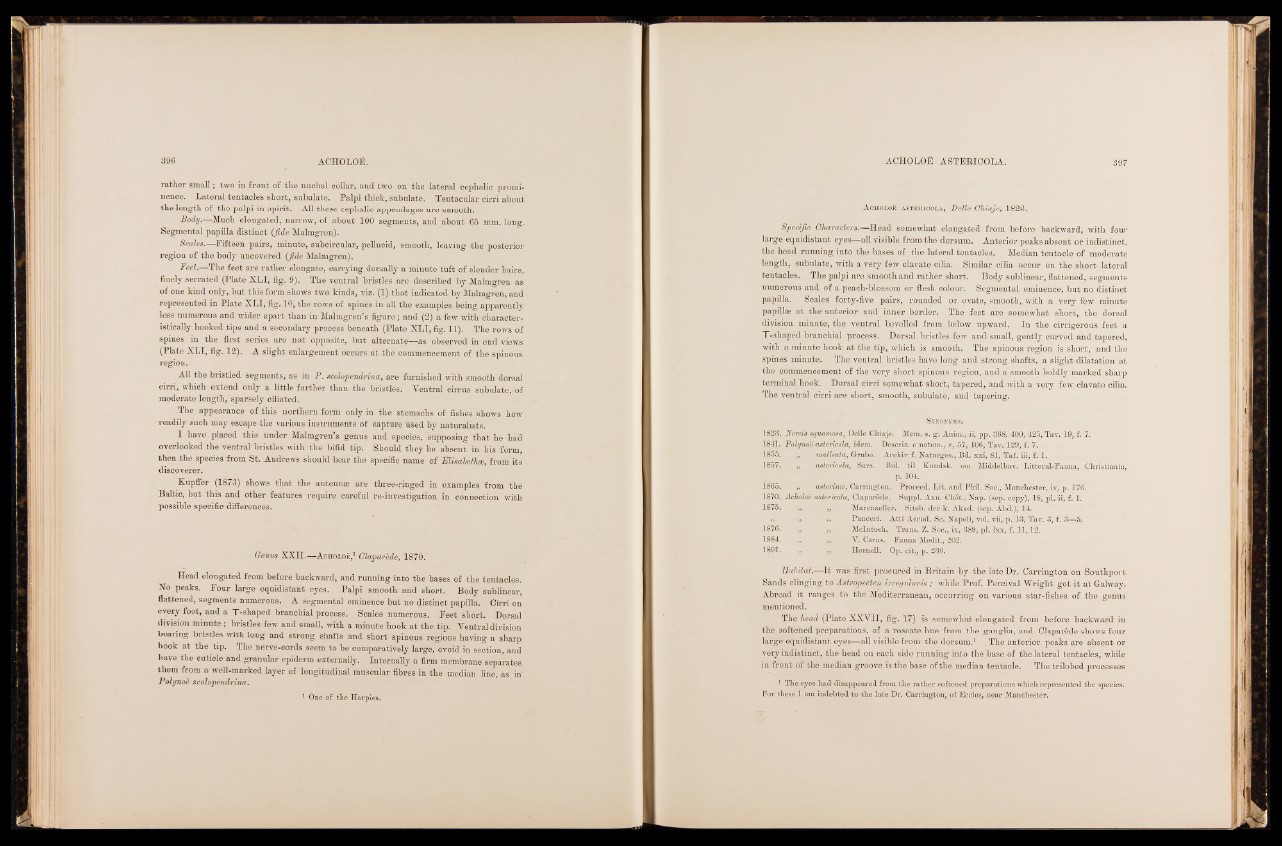
rather small j two in front of the nuchal collar, and two on the lateral cephalic prominence.
Lateral tentacles short, subulate. Palpi thick, subulate. Tentacular cirri about
the length of the palpi in spirit. All these cephalic appendages are smooth.
Body.—Much elongated, narrow, of about 100 segments, and about 65 mm. long.
Segmental papilla distinct (fide Malmgren).
Scales.—Fifteen pairs, minute, subcircular, pellucid, smooth, leaving the posterior
region of the body uncovered (fide Malmgren).
Feet.-—The feet are rather elongate, carrying dorsally a minute tuft of slender hairs,
finely serrated (Plate XLI, fig. 9). The ventral bristles are described by Malmgren as
of one kind only, but this form shows two kinds, viz. (1) that indicated by Malmgren, and
represented in Plate XLI, fig. 10, the rows of spines in all the examples being apparently
less numerous and wider apart than in Malmgren’s figure; and (2) a few with characteristically
hooked tips and a secondary probess beneath (Plate XLI, fig. 11). The rows of
spines in the first series are not opposite, but alternate—as observed in end views
(Plate XLI, fig. 12), A slight enlargement occurs at the commencement of the spinous
region.
All the bristled segments, as in P. scolopendnna, are furnished with smooth dorsal
cirri, which extend only a little further than the bristles. Ventral cirrus subulate,'of
moderate length, sparsely ciliated.
The appearance of this northern form only in the stomachs of fishes shows how
readily such may escape the various instruments of capture used by naturalists.
I have placed this under Malmgren’s genus and species, supposing that he had
overlooked the ventral bristles with the bifid tip. Should they be absent in his form
then the species from St. Andrews should bear the specific name of Elisabeth#, from its
discoverer.
Kupffer (1873) shows that the antennas are three-ringed in examples from the
Baltic, but this and other features require careful re-investigation in connection with
possible specific differences.
Genus XXII.—Acholoe,1 Claparede, 1870.
Head elongated from before backward, and running into the bases of the tentacles.
No peaks. Four large equidistant eyes. Palpi smooth and short. Body sublinear,
flattened, segments numerous. A segmental eminence but no distinct papilla. Cirri on
every foot, and a T-shaped branchial process. Scales numerous. Feet short. Dorsal
division minute; bristles few and small, with a minute hook at the tip. Ventral division
bearing bristles with long and strong shafts and short spinous regions having a sharp
hook at the tip. The nerve-cords seem to be comparatively large, ovoid in section, and
have the cuticle and granular epiderm externally. Internally a firm membrane separates
them from a well-marked layer of longitudinal muscular fibres in the median line, as in'
Polynoe scolopendrina.
1 One of the Harpies.
Acholoe astericola, Belle Ghiaje, 1823.
Specific Characters.—Head somewhat elongated from before backward, with four
large equidistant eyes—all visible from the dorsum. Anterior peaks absent or indistinct,
the head running into the bases of the lateral tentacles. Median tentacle of moderate
length, subulate, with a very few clavate cilia. Similar cilia occur on the short lateral
tentacles. The palpi are smooth and rather short. Body sublinear, flattened, segments
numerous and of a peach-blossom or flesh colour. Segmental eminence, but no distinct
papilla. Scales forty-five pairs, rounded or ovate, smooth, with a very few minute
papillas at the anterior and inner border. The feet are somewhat short,, the dorsal
division minute, the ventral bevelled from below upward. In the cirrigerous feet a
T-shaped branchial process. Dorsal bristles few and small, gently curved and tapered,
with a minute hook at the tip, which is smooth. The spinous region is short, and the
spines minute. The ventral bristles have long and strong shafts, a slight dilatation at
the commencement of the very short spinous region, and a smooth boldly marked sharp
terminal hook. Dorsal cirri somewhat short, tapered, and with a very few clavate cilia.
The ventral cirri are short, smooth, subulate, and tapering.
S ynonyms.
1823. Nereis squamosa, Delle Chiaje. Mem. s. g. Anim., ii, pp. 368, 400, 425, Tav. 19, f. 7.
1841. Polynoe astericola, idem. Descriz. e notom., v, 57, 106, Tav. 129, f. 7.
1855. „ malleata, Grube. Archiv f. Naturges., Bd. xxi, 81, Taf. iii, f. 1.
1857. „ astericola, Sars. Bid. til Kundsk. pm Middelhav. Littoral-Fauna, Christiania,
p. 104.
1865. „ asterinse, Carrington. Proceed. Lit. and Phil. Soc., Manchester, iv, p. 176.
1870. Acholoe astericola, Claparède. Suppl. Ann. Chét., Nap. (sep. copy), 18, pi. ii, f. 1.
1875. „ ,, Marenzeller. Sitzb. der k. Akad. (sep. Abd.), 14.
» j} 33 Panceri. Atti Accad. Sc. Napoli, vol. vii, p. 13, Tav. 3, f. 3—5.
1876. „ „ McIntosh. Trans. Z. Soc., ix, 389, pi. Ixx, f. 11,12.
1884. „ ,, Y. Carus. Fauna Medit., 202.
1891. ,, ,, Hornell. Op. cit., p. 236.
Habitat.—It was first procured in Britain by the late Dr. Carrington on Southport
Sands clinging to Astropecten irregularis ; while Prof. Percival Wright got it at Galway.
Abroad it ranges to the Mediterranean, occurring on various star-fishes of the genus
mentioned.
The head (Plate XXVII, fig. 17) is somewhat elongated from before backward in
the softened preparations, of a roseate hue from the ganglia, and Claparède shows four
large equidistant eyes—all visible from the dorsum.1 The anterior peaks are absent or
very indistinct, the head on each side running into the base of the lateral tentacles, while
in front of the median groove is the base of the,median tentacle. The trilobed processes
1 The eyes had disappeared from the rather softened preparations which represented the species.
For these I am indebted to the late Dr. Carrington, of Eccles, near Manchester.